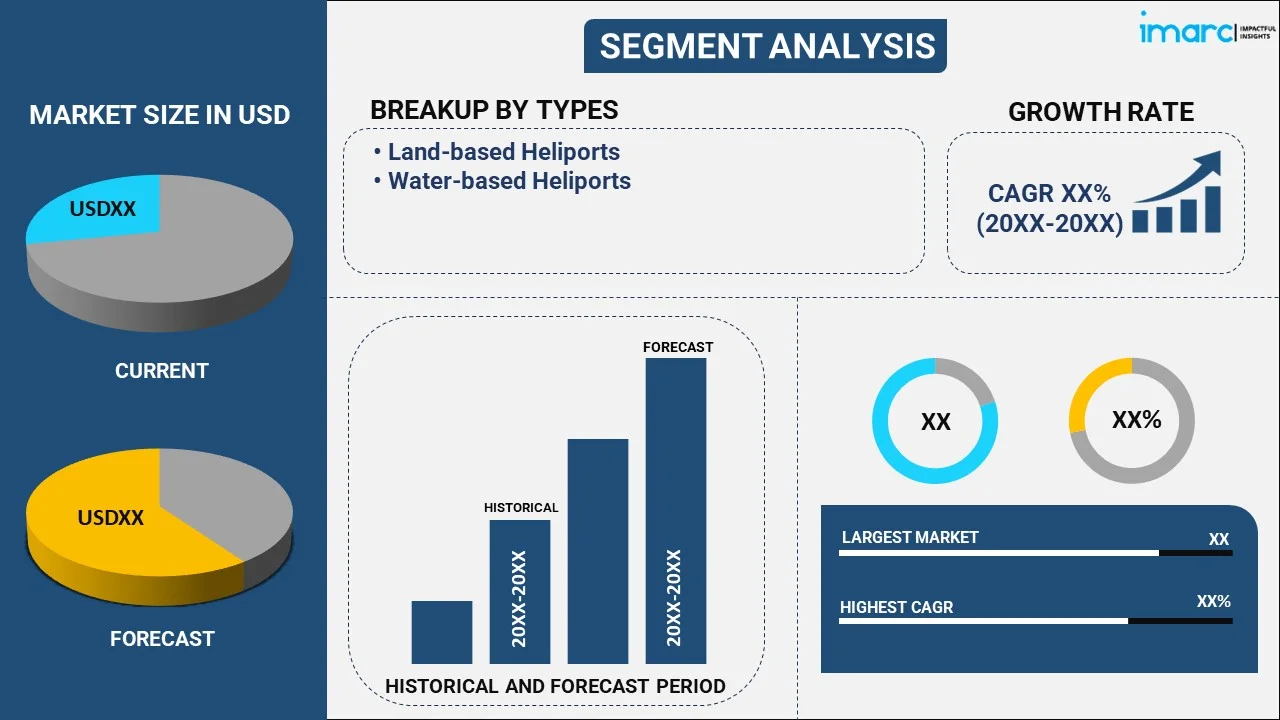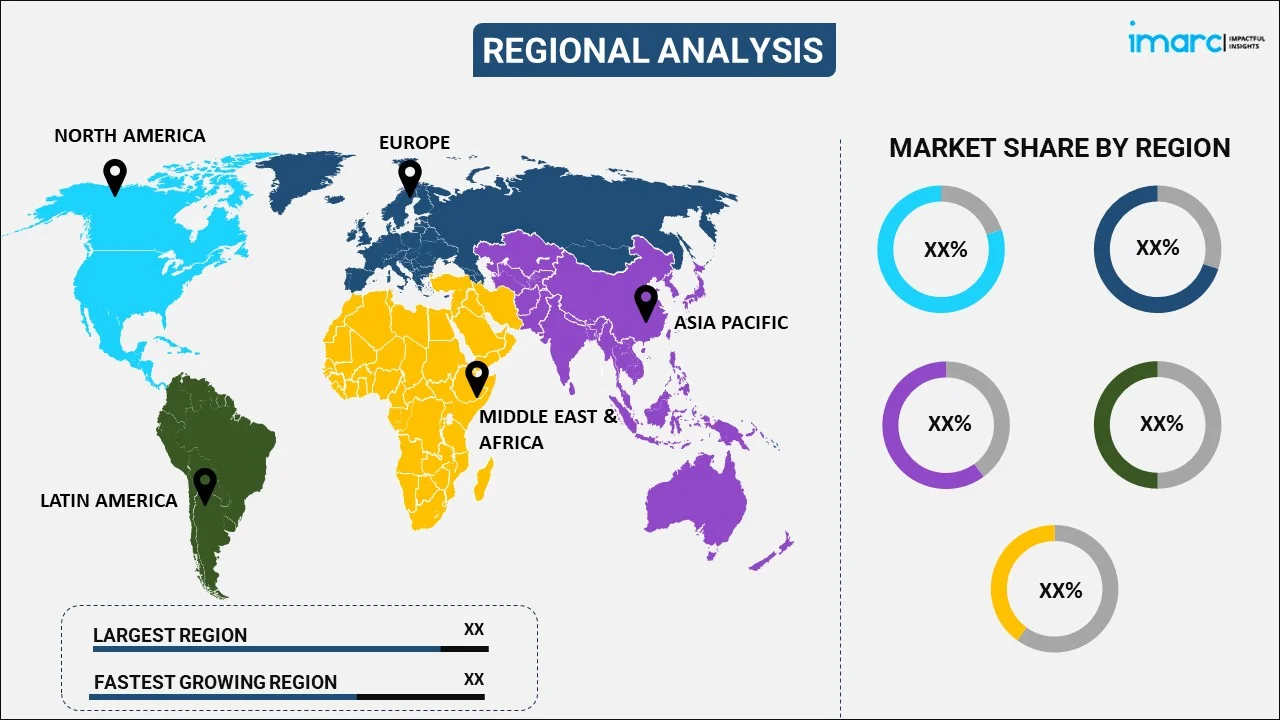
Heliports Market Report by Type (Land-based Heliports, Water-based Heliports), Product Type (Surface Level Heliports, Rooftop Heliports, Elevated Heliports), Mode of Operation (Portable, Fixed), End Use (Commercial, Private, Public, Ambulance), and Region 2025-2033
Market Overview:
The global heliports market size reached USD 567.8 Million in 2024. Looking forward, IMARC Group expects the market to reach USD 669.2 Million by 2033, exhibiting a growth rate (CAGR) of 1.94% during 2025-2033. A considerable rise in the volume of air traffic, the increased upstream investments in oil and gas exploration projects, and the rising heliport installations in rooftops of skyscrapers due to the growing tourism activities represent some of the key factors driving the market.
|
Report Attribute
|
Key Statistics
|
|---|---|
|
Base Year
|
2024
|
|
Forecast Years
|
2025-2033
|
|
Historical Years
|
2019-2024
|
|
Market Size in 2024
|
USD 567.8 Million |
|
Market Forecast in 2033
|
USD 669.2 Million |
| Market Growth Rate 2025-2033 | 1.94% |
Heliports refer to an area of land, water, or adjoining structure, such as buildings and helipads, that are used for the take-off and landing of helicopters. The helipads on the heliports supporting the aircraft are usually made up of steel or aluminum. Heliports range from simple unprepared fields to airfields equipped with hangars, fuel, and aircraft maintenance capabilities. An aircraft's obstacle-clear area is generally determined by its length or the size of its rotor system. The open area can range in size from a two-seat helicopter to a medium twin-engine helicopter, or up to several acres for facilities serving multiple aircraft. Some designated heliports may also have limited facilities like fuel storage or hangars in addition to touchdown and lift-off areas. Heliports are erected and maintained at authorized airports and on top of high-rise buildings with an open court.

Heliports Market Trends:
Increasing urban air mobility (UAM) demand
The emergence of UAM necessitates the creation of a specialized infrastructure to enable frequent, short-distance flights within cities. Heliports, which were formerly used for helicopters, are being repurposed and altered to accept eVTOL aircraft, which can take off and land vertically like helicopters. As UAM is growing, additional heliports will be required to act as hubs for these vehicles, particularly in densely populated urban areas where traditional airports are too far away or crowded. With UAM promising to relieve traffic congestion and provide faster, greener commuting options, demand for urban air mobility services is increasing. This expansion in UAM services, whether for passenger transportation, cargo delivery, or emergency services, necessitates a network of heliports strategically situated in and around cities. More heliports will be needed in crucial regions such as city centers, commercial districts, and near transport hubs to facilitate seamless air travel.
Growth in medical and emergency services
Helicopters are widely utilized for air ambulance services, transporting urgent patients to hospitals. Air travel is frequently the fastest and most dependable alternative for reaching medical institutions in urban regions with significant traffic congestion or rural areas where ground transportation may be slow or difficult. The increased demand for rapid response times is resulting in an increase in the number of heliports placed at or near hospitals, trauma centers, and other emergency response facilities. As more hospitals include heliports into their emergency services, the demand for heliport infrastructure is growing, particularly in areas where access to healthcare is limited or where prompt transportation can save lives. Helicopters play an important part in search and rescue efforts during natural disasters, accidents, and in isolated locations. When ground access is limited owing to topography, water, fires, or other impediments, helicopters are an effective way to reach affected regions rapidly.
Rising demand for corporate air travel
Corporate executives frequently have tight schedules and little time for travel. Helicopter flight allows them to avoid land traffic and get at their destinations considerably faster. As the need for speedy travel alternatives is developing, firms are investing more in heliports to accommodate this mode of transportation, particularly in cities where traffic congestion is a big concern. Many businesses operate in remote areas or sites that are difficult to access via traditional transportation methods. Heliports provide direct access to these locations, which reduces travel time and increases production. The demand for quick travel solutions to remote work sites is driving the development of more heliports in critical places, such as oil fields, mining operations, and agricultural sites. Many organizations are collaborating with helicopter service providers to create dedicated heliports for their personnel. These collaborations frequently include the construction of heliports at company offices or neighboring locations, which provide simple access to helicopter transportation for business meetings and site inspections. This trend is driving the construction and upgrading of heliports to meet corporate travel demands.
Key Market Segmentation:
IMARC Group provides an analysis of the key trends in each segment of the global heliports market, along with forecasts at the global, regional, and country level from 2025-2033. Our report has categorized the market based on type, product type, mode of operation, and end use.
Type Insights:

- Land-based Heliports
- Water-based Heliports
The report has provided a detailed breakup and analysis of the heliports market based on the type. This includes land-based heliports and water-based heliports. According to the report, land-based heliports represented the largest segment.
Product Type Insights:
- Surface Level Heliports
- Rooftop Heliports
- Elevated Heliports
The report has provided a detailed breakup and analysis of the heliports market based on the product type. This includes surface level heliports, rooftop heliports, and elevated heliports. According to the report, surface level heliports represented the largest segment.
Mode of Operation Insights:
- Portable
- Fixed
The report has provided a detailed breakup and analysis of the heliports market based on the mode of operation. This includes portable and fixed. According to the report, fixed represented the largest segment.
End Use Insights:
- Commercial
- Private
- Public
- Ambulance
A detailed breakup and analysis of the heliports market based on the end use has also been provided in the report. This includes commercial, private, public, and ambulance. According to the report, commercial accounted for the largest market share.
Regional Insights:

- North America
- United States
- Canada
- Asia Pacific
- China
- Japan
- India
- South Korea
- Australia
- Indonesia
- Others
- Europe
- Germany
- France
- United Kingdom
- Italy
- Spain
- Russia
- Others
- Latin America
- Brazil
- Mexico
- Others
- Middle East and Africa
The report has also provided a comprehensive analysis of all the major regional markets that include North America (the United States and Canada); Asia Pacific (China, Japan, India, South Korea, Australia, Indonesia, and others); Europe (Germany, France, the United Kingdom, Italy, Spain, Russia, and others); Latin America (Brazil, Mexico, and others); and the Middle East and Africa. According to the report, North America was the largest market for heliports. Some of the factors driving the North America heliports market include considerable growth in the tourism industry, inflating disposable income levels, the rising adoption of heliports for emergency transportation during disaster management, etc.
Competitive Landscape:
The report has also provided a comprehensive analysis of the competitive landscape in the global heliports market. Detailed profiles of all major companies have also been provided. Some of the companies covered include:
- Aluminium Offshore Pte Ltd
- Bnnaviation
- FEC Heliports
- Helidex LLC
- Heliport Systems Inc.
- Helitecnica
- Technokontrol Global Ltd.
Kindly note that this only represents a partial list of companies, and the complete list has been provided in the report.
Heliports Market News:
- July 2024: The Dubai Civil Aviation Authority (DCAA) issued certification to Air Chateau DWC, giving it clearance to develop new vertiports and heliports. This approval will allow it to press ahead with plans that include a large-scale helicopter project in the UAE.
- August 2023: Altitude Angel, the world’s leading Unified Traffic Management (UTM) technology provider, announced that the London heliport is deploying its approval services platform which allows drone operators, and in the future eVTOL pilots, the ability to request and pay for operations within the heliport’s airspace digitally and at the touch of a button.
Report Scope:
| Report Features | Details |
|---|---|
| Base Year of the Analysis | 2024 |
| Historical Period | 2019-2024 |
| Forecast Period | 2025-2033 |
| Units | Million USD |
| Segment Coverage | Type, Product Type, Mode of Operation, End Use, Region |
| Region Covered | Asia Pacific, Europe, North America, Latin America, Middle East and Africa |
| Countries Covered | United States, Canada, Germany, France, United Kingdom, Italy, Spain, Russia, China, Japan, India, South Korea, Australia, Indonesia, Brazil, Mexico |
| Companies Covered | Aluminium Offshore Pte Ltd, Bnnaviation, FEC Heliports, Helidex LLC, Heliport Systems Inc., Helitecnica, Technokontrol Global Ltd, etc. |
| Customization Scope | 10% Free Customization |
| Post-Sale Analyst Support | 10-12 Weeks |
| Delivery Format | PDF and Excel through Email (We can also provide the editable version of the report in PPT/Word format on special request) |
Key Questions Answered in This Report:
- How has the global heliports market performed so far and how will it perform in the coming years?
- What are the drivers, restraints, and opportunities in the global heliports market?
- What are the key regional markets?
- Which countries represent the most attractive heliports markets?
- What is the breakup of the market based on the type?
- What is the breakup of the market based on the product type?
- What is the breakup of the market based on the mode of operation?
- What is the breakup of the market based on the end use?
- What is the competitive structure of the global heliports market?
- Who are the key players/companies in the global heliports market?
Key Benefits for Stakeholders:
- IMARC’s report offers a comprehensive quantitative analysis of various market segments, historical and current market trends, market forecasts, and dynamics of the heliports market from 2019-2033.
- The research study provides the latest information on the market drivers, challenges, and opportunities in the global heliports market.
- The study maps the leading as well as the fastest growing regional markets. It further enables stakeholders to identify the key country-level markets within each region.
- Porter's five forces analysis assist stakeholders in assessing the impact of new entrants, competitive rivalry, supplier power, buyer power, and the threat of substitution. It helps stakeholders to analyze the level of competition within the heliports industry and its attractiveness.
- Competitive landscape allows stakeholders to understand their competitive environment and provides an insight into the current positions of key players in the market.
Need more help?
- Speak to our experienced analysts for insights on the current market scenarios.
- Include additional segments and countries to customize the report as per your requirement.
- Gain an unparalleled competitive advantage in your domain by understanding how to utilize the report and positively impacting your operations and revenue.
- For further assistance, please connect with our analysts.
 Inquire Before Buying
Inquire Before Buying
 Speak to an Analyst
Speak to an Analyst
 Request Brochure
Request Brochure
 Request Customization
Request Customization




.webp)




.webp)












